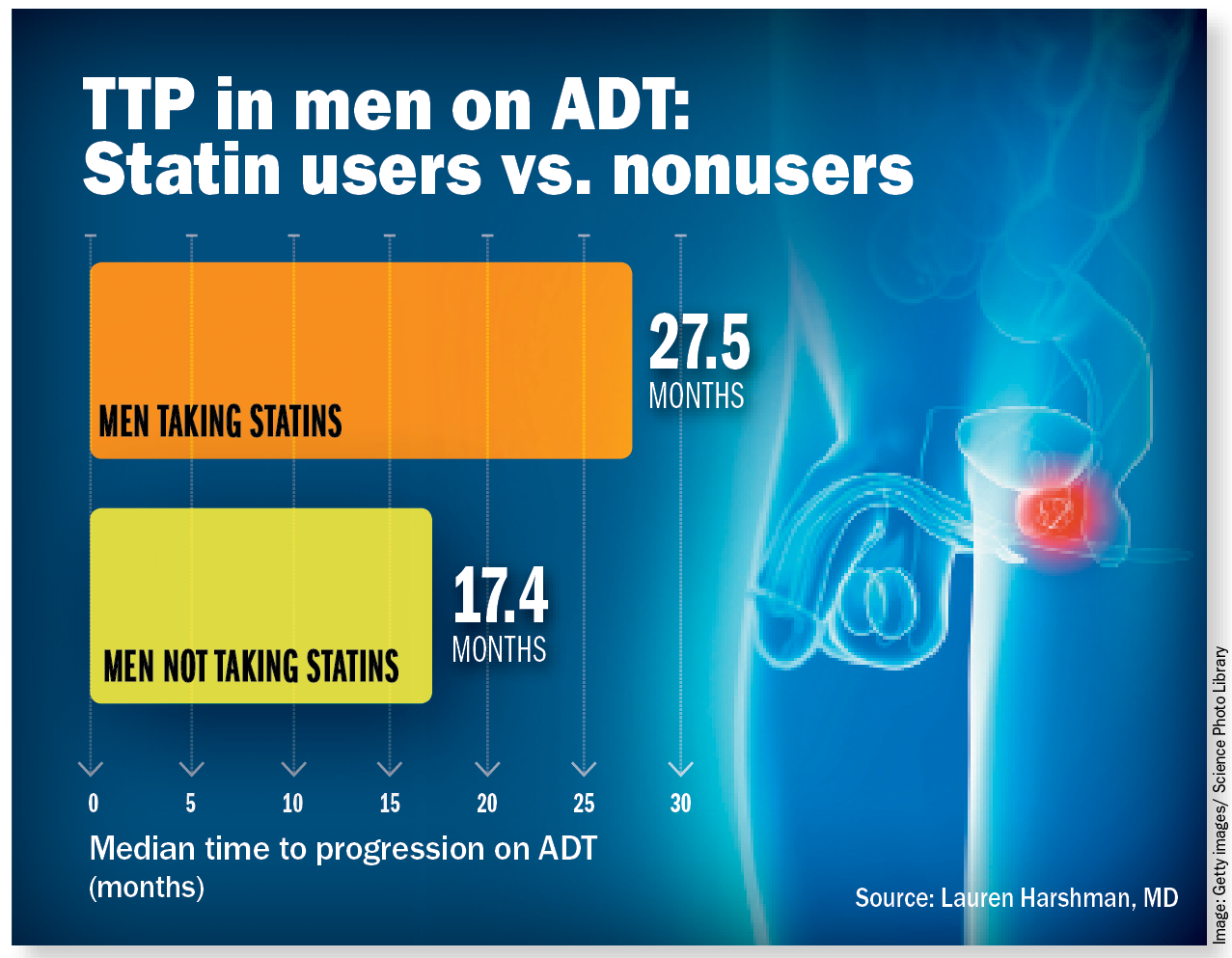Article
Statins may improve prostate cancer outcomes
Author(s):
Statins may improve outcomes in hormone-sensitive prostate cancer, and one possible mechanism responsible may have been discovered.
Orlando, FL-Statins may improve outcomes in hormone-sensitive prostate cancer, and one possible mechanism responsible may have been discovered.
RELATED: Genetic variations linked to increased PCa risk identified
Two retrospective studies presented at the Genitourinary Cancers Symposium in Orlando, FL showed an increase in the time to disease progression (TTP) in users of statins who initiated androgen deprivation therapy (ADT), and one of the two studies also showed improved overall and prostate cancer-specific survival in statin users treated with ADT following primary or salvage radiation therapy. A third study found that lethal prostate cancers have potentially lower cholesterol uptake.

Robert Hamilton, MD, MPHAmong 1,364 men with PSA levels >3.0 ng/mL after 1 year of radiotherapy who were randomized to intermittent or continuous ADT, statin users had a significant reduction in the risk of death compared with non-users, reported first author Robert Hamilton, MD, MPH, urologic oncologist at Princess Margaret Cancer Center, Toronto, and assistant professor of surgical oncology, University of Toronto.
Few studies have looked at the effect of statin use in advanced prostate cancer or in combination with ADT, he said.
Of the 1,364 patients enrolled, 585 (43%) reported statin use during the study. At a median follow-up of 6.9 years, statin use was associated with a 36% reduction in the risk of overall death (p<.001) and a 36% reduction in the risk of prostate cancer-specific mortality (p=.003).
Statin users had 14% longer time to castrate-resistant disease, although this difference was not significant (p=.15). In the arm randomized to intermittent ADT, statin users had more off-treatment intervals (p=.04) and more total time off ADT (hazard ratio [HR]=0.84; p=.05). Quality of life measures were also significantly better in statin users versus non-users.
“At the present time we do not have enough evidence to tell a patient about to start ADT that they should also start a statin. However, if a patient on ADT is about to start a statin for high cholesterol, you can tell them that there may be another reason to feel good about taking your statin than just treating your cholesterol,” said Dr. Hamilton.
NEXT: Statins increase TTP by 10 months
Statins increase TTP by 10 months
A second retrospective study showed that men who were taking a statin at the time of ADT initiation had an increased median TTP by about 10 months compared with those who were not on a statin, said first author Lauren Harshman, MD, assistant professor of medicine, Harvard Medical School, Dana-Farber Cancer Institute, Boston.
READ: FDA approves label update for advanced PCa treatment
Preclinical work by the Kantoff Laboratory suggested that statins decrease influx of dehydroepiandrosterone (DHEAS) by competing for its uptake by the organic anionic transporter SLCO2B1.
“Dr. Wang in the Kantoff Laboratory evaluated how different statins affect DHEAS uptake by SLCO2B1, and found using two androgen-sensitive cell lines that statins inhibited DHEAS uptake,” she said. “Specifically, atorvastatin was found to decrease DHEAS-induced prostate cancer cell proliferation likely by competing for influx through SLCO2B1.”
The investigators were able to further prove with knockdown studies that inhibition of DHEAS uptake was dependent on SLCO2B1 expression.
“If you knock down that transporter, the administration of atorvastatin doesn’t inhibit tumor cell proliferation, which supports the finding that the transporter is important for the statin’s inhibitory effect on the influx of DHEAS into the tumor cell,” said Dr. Harshman.
Her group therefore hypothesized that patients on statins at the time of ADT initiation would have improved prostate cancer outcomes. An interrogation of Dana-Farber’s clinical database of treatment details and outcomes of patients with prostate cancer identified 1,265 patients with hormone-sensitive disease who had been treated with ADT. After excluding patients with inadequate information on PSA response to ADT or whose statin use was not known, 926 were left for analysis. Of those, 31% were taking a statin at ADT initiation, and most of them remained on a statin throughout ADT use. Statin use generally increased over time.
Disease progression was defined as two PSA rises. Date of progression was defined as date of first PSA rise or radiologic progression. After a median follow-up of 5.8 years, 70% of patients had progressed on ADT.
Men on statins had a longer median TTP on ADT compared with nonusers-27.5 versus 17.4 months. On multivariate analysis, adjusting for biopsy Gleason score, primary therapy type, metastatic status, and PSA level at ADT initiation, the association remained statistically significant (adjusted HR: 0.83; p=.039).
“This work is retrospective and requires validation, but it fits with the preclinical data suggesting that one reason that statins may impact outcomes on ADT is through competitive influx via the transporter, thus decreasing the tumor’s available androgen stores” she said. “The widespread use of statins and their generally tolerability make them attractive candidates to combine with our other known effective therapies.”
NEXT: Lower LDL expression in lethal PCa

Lower LDL expression in lethal PCa
A third study, this one a nested case-control study within the Health Professionals Follow-up Study prostate cancer cohort, discovered that lethal prostate cancers have lower expression of the LDL receptor, and potentially lower cholesterol uptake. The study included 249 men who underwent curative-intent prostatectomy, 81 men who died of prostate cancer, and 168 controls who survived for more than 8 years without evidence of metastasis.
“We went to where the money is and looked into the expression of genes of cholesterol metabolism and their association with prostate cancer outcomes,” said lead investigator Konrad H. Stopsack, MD, MPH, internal medicine resident at Mayo Clinic, Rochester, MN, who worked on the study with Jennifer R. Rider, ScD, MPH, and colleagues at Harvard T.H. Chan School of Public Health, Boston.
Patients who had very high mRNA expression of the LDL receptor were at decreased risk of prostate cancer-specific mortality, whereas those with very high expression of the second rate-controlling enzyme of cholesterol synthesis, squalene epoxidase (SQLE), had a significantly greater risk of dying from prostate cancer.
Discrimination among high-grade tumors improves when adding the LDL receptor and SQLE genes to a full predictive model of prostate cancer-specific mortality in the long term, Dr. Stopsack said.
“Patients are much more likely to die from the cancer when it’s very active in producing cholesterol,” he said.
Dr. Hamilton has received honoraria from Bayer and Janssen. Dr. Harshman is a consultant/adviser for Bristol-Myers Squibb, Dendreon, Medivation/Astellas, and Pfizer, and has received research funding from Medivation/Astellas and Pfizer.
You might also like:
Androgen receptor inhibitor shows significant PFS increase
Delayed RP does not raise adverse pathology risk
Significant OS improvement seen with mCRPC Tx vs. placebo
Subscribe to Urology Times to get monthly news from the leading news source for urologists.
Newsletter
Stay current with the latest urology news and practice-changing insights — sign up now for the essential updates every urologist needs.













